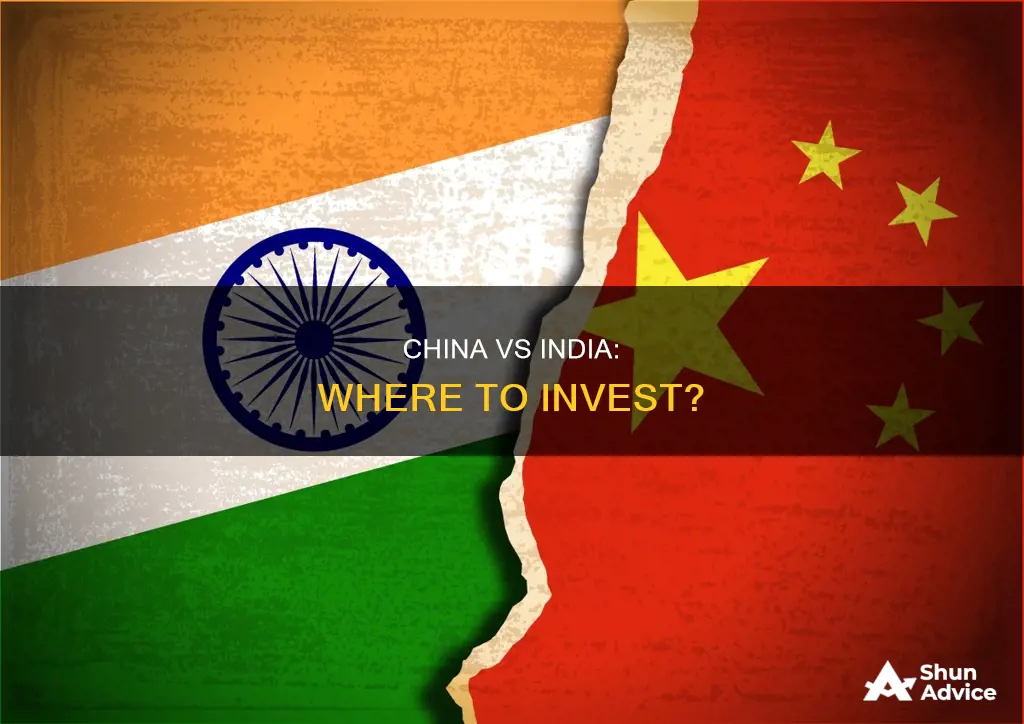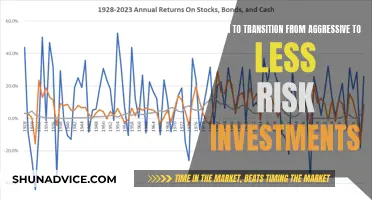
India and China are two of the world's fastest-growing economies, offering a range of investment opportunities. Both countries have experienced opposite economic fortunes, with India's economy booming and China's slowing down. India's market is driven by domestic consumption and a growing middle class, while China's economy is mainly export-led. India's stocks have seen huge inflows, while China's stocks are considered undervalued and a potential value trap. Investors need to consider the risks and rewards of investing in each country, including geopolitical tensions, regulatory differences, and insider trading. With India's growing population and economic potential, it could experience a long-term investment boom. On the other hand, China's urbanization and economic growth create investment opportunities, but there are concerns about sustainability and political policies.
What You'll Learn

China's economic growth is slowing, while India's is booming
The contrasting economic trends in China and India have had a significant impact on their stock markets. India's stock market has been attracting investors with its strong economic growth and business-friendly reforms, resulting in huge inflows. In contrast, China's stock market has seen outflows as investors are cautious about the country's sluggish economy and real estate sector. However, with Chinese stocks looking cheap, some investors are wondering if it is a good time to buy.
Looking ahead, India's economy is expected to continue its strong growth trajectory. The International Monetary Fund (IMF) predicts India's economy to grow by 5.7% in 2024 and 6.8% in 2025. India's market capitalization is also predicted to grow, and the country is expected to become the third-largest economy in the world by 2028. On the other hand, China's economic growth is expected to slow further, with a projected growth rate of 4.6% in 2024 and 4.1% in 2025.
When deciding whether to invest in China or India, it is essential to consider the risks and opportunities presented by each market. India's high oil imports make its economy vulnerable to high oil prices, and its stock market is known for its volatility. Meanwhile, China's economy is facing challenges due to its property crisis and rising geopolitical tensions. However, the Chinese government's efforts to stimulate the economy and the potential for a rebound in consumer spending could create buying opportunities for long-term investors.
Understanding Your Investment Portfolio Report: A Guide
You may want to see also

China's stocks are cheap, but are they a value trap?
Chinas stocks are cheap, but are they a value trap?
China's stocks are now looking temptingly cheap, but investors are faced with the question of whether these shares are a value trap or whether fortune might favour the brave.
The case for investing in China
China's impressive economic growth has been driven by urbanization, which is expected to continue for at least the next 20 years. This process involves the development and building of cities, requiring growth in infrastructure, commerce, and other services. As a result, businesses begin to sprout up, many of which create wealth for shareholders.
China's economy is expected to grow by 4.5% in 2024, with stability in domestic growth and exports, positive shifts in investor sentiment, and low inflation. The long-term case for investing in China's growth story remains intact, with the growth of the middle class and the economy's refocus on domestic consumption expected to drive economic growth and the stock market in the coming years.
The case for caution
China's economy has been sluggish recently, dragged down by a property crisis, rising geopolitical tensions, and troubles in the real estate market. There are also concerns about China's mounting debt, the sustainability of its economic growth, and its political policies.
Value trap stocks appear to be value stocks with low P/E and other low fundamental ratios. However, they can be cheap for a reason, such as a company's struggling earnings growth.
So, is it a value trap?
Some experts describe Chinese shares as value traps, while others say they are a buying opportunity of a lifetime. While there are risks, including global macroeconomic factors and geopolitical tensions, it is worth noting that some of the world's biggest money managers have been buying Alibaba stock recently.
According to value investors, a value share should have four main criteria: a price-to-earnings (PE) ratio below the market average, the payment of a dividend, no debt on the company's books, and a price-to-book ratio below its tangible book value.
While Chinese stocks may meet some of these criteria, it is important to remember that value shares need an "outer", or an event that allows their true value to surface. With the drip of bad news about China, there is little reason for the market to push up share prices.
However, true value investors argue that only the fundamentals of a company matter, and that geopolitical events, management acumen, prevailing economic conditions, and government policy are irrelevant.
While there are risks, China's stocks may not be a value trap. However, investors should proceed with caution and carefully consider the fundamentals of the companies they invest in.
Investing in India: A Guide to Making Smart Choices
You may want to see also

India's market capitalization is closely tied to its GDP
India's market capitalization and its gross domestic product (GDP) have risen in tandem over the past two decades. In 2023, India's market capitalization accounted for 123.3% of its nominal GDP, up from 104.8% in the previous year. This close correlation between market capitalization and GDP indicates that India's stock market performance reflects the overall health of its economy.
India's market capitalization and GDP have grown significantly over the years. In the early 2000s, India's GDP was around $500 billion, and its market capitalization was proportionally smaller. By 2023, India's GDP had surged to $3.5 trillion, with market capitalization rising in step. This growth has attracted investors, who are willing to pay a premium for Indian stocks despite their relatively high valuation.
The International Monetary Fund (IMF) predicts that India's economy will continue to grow, with an expected growth rate of 5.7% in 2024 and 6.8% in 2025. This positive outlook is supported by India's strong domestic consumption, which accounts for around 60% of its economy. As the country's population increases, so do the aspirations and incomes of its young, educated population. India's middle class is projected to expand from 50 million to 475 million by 2030, driving further economic growth.
However, it is important to consider the risks associated with investing in India. High oil prices, for instance, could destabilize India's economy as it is one of the largest importers of oil globally. Additionally, investors should be mindful of the volatility of Indian stock markets, which can be significantly impacted by global market fluctuations. Nonetheless, India's long-term growth story and the correlation between its market capitalization and GDP make it an attractive investment destination.
Shark Tank India Success Stories: How Many Paid Off?
You may want to see also

China's economy is expected to grow slower than India's
China's economy has been growing slower than India's and this trend is expected to continue for the foreseeable future.
Economic Growth
China's economy has been sluggish, dragged down by a property crisis, mounting local government debt, and rising geopolitical tensions. Its gross domestic product (GDP) grew by 4.7% year-over-year in the second quarter of 2024, which was below expectations. This marked a slowdown from the 5.3% growth in the first quarter and missed the forecast of 5.0% by economists.
On the other hand, India's economy is booming, with strong economic growth and business-friendly reforms. India's GDP is expected to grow by 5.7% in 2024 and 6.8% in 2025, according to the International Monetary Fund. This growth is driven by domestic consumption, and private consumption currently accounts for around 60% of India's economy.
Market Capitalization
India's market capitalization closely tracks its gross domestic product (GDP) and has risen from $500 billion to $3.5 trillion over the past two decades. Investors are willing to pay a premium for Indian shares, anticipating continued growth.
In contrast, China's market capitalization is smaller than its share of global GDP, and its stocks are now looking temptingly cheap. However, investors are unsure if these shares are a value trap or if fortune will favor the brave.
Population and Demographics
India recently surpassed China as the world's most populous nation and continues to grow. India's biggest asset is its young, vibrant, and educated population. As their incomes rise, more young people move to the cities, and their lifestyles and aspirations evolve. India's middle class is expected to grow from 50 million today to 475 million by 2030, presenting a vast consumer market.
Investment Opportunities
Given the contrasting economic fortunes of the two countries, investment inflows have shifted from Chinese stocks to Indian stocks. Goldman Sachs and Morgan Stanley currently list India as their top investment destination for the coming decade, predicting that it will become the third-largest stock market in the world by 2030.
While Chinese stocks are now cheaper, there are concerns about a value trap, and investors need to carefully consider the risks and rewards. Some investors are buying Alibaba stock, which is trading at cheap valuations and has strong cash flow.
In conclusion, China's economy is expected to grow slower than India's in the coming years. India's booming economy, driven by domestic consumption and favorable demographics, makes it an attractive investment destination. However, investors considering Chinese stocks should be aware of the risks, including regulatory differences and insider trading issues, while also keeping an eye out for potential buying opportunities.
Managing Investment Biases: Strategies for Objective Financial Decisions
You may want to see also

China's urbanization is a key driver of its economic growth
Urbanization has been an important instrument for economic development and reducing regional income disparity in China. As people shift from living an agrarian lifestyle to an urbanized one, cities need to be developed and built, requiring growth in infrastructure, commerce, and other services. As individuals begin to specialize, education becomes more important, and an educated society is typically wealthier. As per capita wealth improves, the quality of life improves, and businesses begin to sprout up, creating wealth for shareholders.
The scale of urbanization in China is unprecedented in human history, and it is expected to continue past 2030. This urbanization is reshaping both the physical environment and the cultural fabric of China. For example, huge cities place huge demands on the environment, but high-density living conditions also present opportunities for improving energy efficiency.
There is a strong relationship between the percentage of the population engaged in agriculture and the country's per capita GDP. Urbanization is driving economic development in China, and the Chinese government has indicated that it is one of their top agenda items for the next ten years. The growth of China's middle class and the refocusing of its economy towards domestic consumption are expected to be key drivers of economic growth and the stock market in the coming years.
Smartly Investing 15 Lac in India: A Beginner's Guide
You may want to see also
Frequently asked questions
India's economy is booming, with strong economic growth and business-friendly reforms. It has a diverse range of companies with good fundamentals that can take advantage of the untapped growth potential. India's market capitalization passed the UK and France in 2024 and is predicted to become the third-largest economy by 2028.
Indian stock markets can be extremely volatile, and high oil prices could destabilize India's economy.
China has impressive economic growth driven by urbanization, which is expected to continue past 2030. China's economy is expected to grow by 4.5% in 2024, and its stocks are currently looking temptingly cheap.
China is a communist country with different regulatory standards and insider trading issues. Its economic recovery has been stuttering, and there are concerns about mounting debt and the sustainability of its economic growth.
Both countries offer investment opportunities, but it depends on your risk appetite and investment goals. India's economy is growing faster, but China's stocks are currently cheaper. India may be a better option for long-term growth, while China may offer more short-term gains if its economy recovers.







